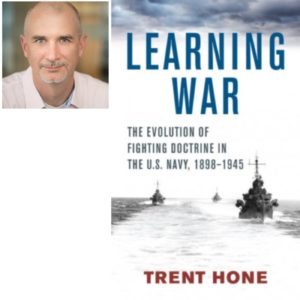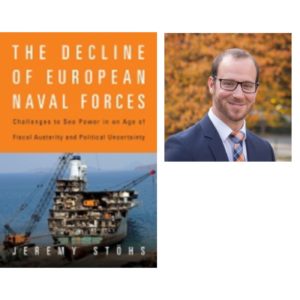Podcast: Play in new window | Download
Subscribe: RSS

Trent Hone was written frequently on US Naval history. I interviewed him about his upcoming book Learning War: The Evolution of Fighting Doctrine in the US Navy, 1898-1945 to be published by the Naval Institute Press.
1:45 – Mr. Hone discusses some of his earlier naval doctrine writing. He’s written about night combat in the US Navy in early WWII. He also wrote on how naval doctrine changed over WII. He’s collaborated on different navy history projects. He helped with the WWI navy book To Crown the Waves.
4:45 – Mr. Hone discusses his current book. From the 1890s to the 1940s, the Navy became a learning organization.
8:28 – The Spanish American war is where the US Navy realizes it needs a new institutional structure. This leads to the creation of the General Board in the Navy. Also, there’s a conflict between engineering officers versus line officers. Line officers were then required to be engineering officers and the Naval Academy changed its focus to engineering too.
10:59 – After the Spanish-American war, the US becomes a global empire. The new territories are across the oceans. The General Board thinks seriously about what the Navy should look like with these new overseas commitments.
13:40 – The board is made up of navigation, intelligence, the head of the Navy, and the others. Some leaders in the Navy didn’t trust the Board since it put civilian control over the Navy. The board leads the creation of the Chief of Naval Operations.
16:42 – Surface tactics change before WWI. The Atlantic Fleet was established and the Navy learns how to fight as a fleet rather than as squadrons. They also learn how to use torpedoes in combat. New communications are developed for tactical exercises and new ideas created for independent action.
20:30 – The US Navy went into WWI ready for a big fleet action. But Germany instead uses U-boats to win the war. The US Navy then rushed to built ships good for fighting U-boats.
22:45 – In 1916, the Navy starts to realize that there are many different ways wars can be fought. The Navy begins to grapple with how aviation can be used in the fleet. Submarines are also an uncertainty as far as what their role will be in war.
25:42 – The idea that the Navy was focused on battleships for the next war is a pervasive belief. This idea is tied with the Gun Club, which were admirals focused on big gun battles. There was more diversity in thinking about how the next war would be fought.
29:00 – WWII leaders were adept at using all their available technologies. The Navy generally did promote the best rather than those who were connected politically. Performance mattered. The Navy also created good ways to exchange feedback about important issues. There was also a great deal of creativity during tactical exercises.
32:52 – Mr. Hone looked at exercise reports and doctrinal manuals. But they lacked context about how these ideas were created. He looked at various primary and secondary sources in the National Archives and the Navy War College archives.
37:21 – PBYs were used at night during WWII. There was a large pre-WWII effort to get patrol planes and ships to work together at night. The Navy was also working on destroyer night combat before WWI.
42:00 – Mr. Hone was surprised at how far back some Navy innovations went. He would like to do more research on how the large the spheres of influence of some officers were.
44:22 – Mr. Hone focused on one action on November 13, 1942 at Guadalcanal. History has said that Officer Callahan was confused and overwhelmed at Iron Bottom. However, Navy documents suggest that he used his force the way they were expected to be used against a Japanese battleship.
48:06 – The US Navy learned quicker than the Japanese Navy in WWII and this came from the organizational structure.
53:00 – Guadalcanal has many wrecks that provide information on how the Naval campaign was waged.
53:47 – The book will be on USNI.org and Amazon. His personal website is trenthone.com.
55:00 – The Navy planned for a campaign against the Japan in WWII but they didn’t have an idea of how they would end the campaign. The Japanese focus was on one big battle and they pursued that idea throughout. Pearl Harbor, Midway, and Leyte Gulf were Japanese big battle concepts.
Links
https://www.usni.org/store/books/ebook-editions/crown-waves
For more “Military History Inside Out” please follow me on Facebook at warscholar, on twitter at Warscholar, on youtube at warscholar1945 and on Instagram @crisalvarezswarscholar
Guests: Trent Hone
Host: Cris Alvarez
Tags: world war 2, world war II, wwii, wwi, world war one, world war 1, navy, us navy, sailors, General Board, Naval Academy, naval aviation, torpedoes, submarines, guadalcanal, jutland, spanish-american war, PBY, ironbottom, night fighting, USS Lexington


